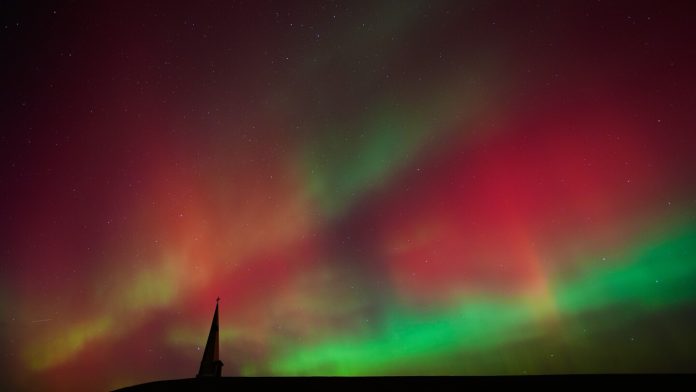VALLEY FALLS, Kansas (AP) — Charlie Riedel has been a staff photographer for The Associated Press based in Kansas City for 25 years. He has covered Olympics, Super Bowls and the Masters among many sporting events in his career. He also has covered presidential elections, weather disasters, the Gulf oil spill and protests.
Here’s what he had to say about this extraordinary photo.
READ MORE FROM OUR ‘ONES’ SERIES
Why this photo?
I’m somewhat passionate about shooting celestial events – moon, sun, comets, lightning, clouds, etc. When I found out there was a good chance the northern lights might dip down as far south as Kansas, I was enroute to shoot a college basketball game. Once the game was over, I checked social media and confirmed people were seeing the aurora in the area, so I decided I needed to try to document this event as it is rarely seen this far south.
How I made this photo
I decided I needed to travel to open country to the north to get away from city lights. As I was traveling into darker countryside, I began to notice a faint greenish glow, giving me hope I might see something. It really was too faint to see well, but after stopping along the road and looking at the sky with my iPhone camera I could tell that glow was indeed the northern lights. Now, the challenge was to find something to include in the foreground of the frame to localize the photo and make it a bit more interesting than just a photo of the sky.
I decided to head to a spot not too far away, which I discovered a few weeks ago while shooting a comet photo. This location was simply a repurposed old church steeple that moved to hilltop with nothing else obstructing the horizon. Once there, as if on command, the sky really lit up. I could see the red and green colors clearly covering most of the northern horizon with some of the light show even stretching overhead. I knew this could be a fleeting experience, so I rushed to set up my tripod and ready my camera. The photo was shot with a Sony A9III camera with a 12-24mm f/4 lens. Exposure was 15 seconds at F/4, ISO 800. Color balance was set on auto. I shot the photo at 12mm to capture as much of the sky as possible but still this wasn’t wide enough to get the entirety of the display. The whole event lasted about 15 minutes and faded away as rapidly as it appeared.
Why this photo works
I think this photo works because it captures a rare event in my part of the country and clearly conveys the essence of Kansas with a big sky and just a single object disrupting the horizon.
For more extraordinary AP photography, click here.







